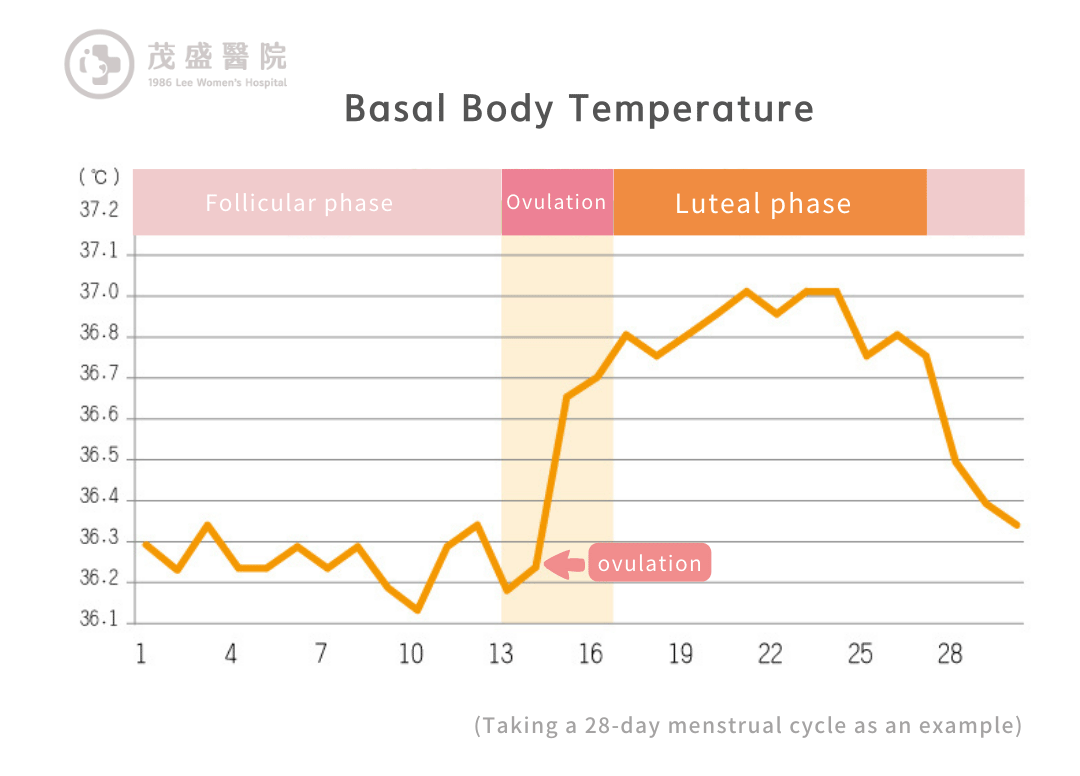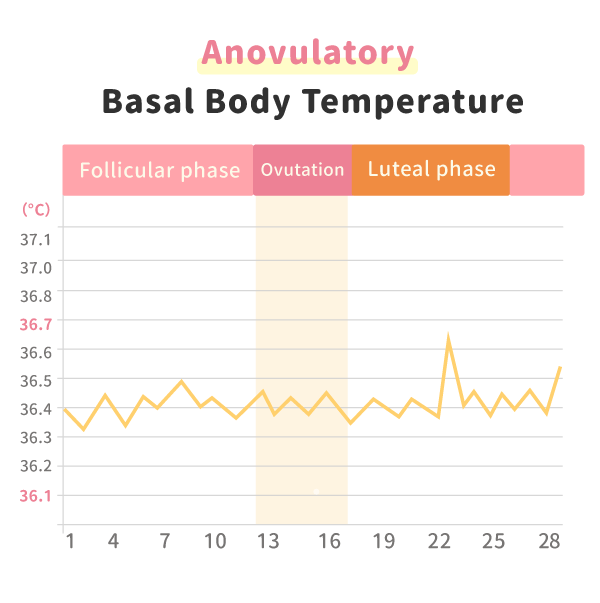Knowledge Sharing
2023.08.15
Basal Body Temperature and Ovulation for Family Planning
By measuring basal body temperature, you can determine whether you are ovulating. This article will help you understand what basal body temperature is, the difference between basal body temperature and general body temperature, and how to accurately measure basal body temperature.
Generally, in adult females, the body temperature decreases before ovulation and rises by approximately 0.3-0.6 °C after ovulation. As the next menstrual cycle approaches, the temperature returns to normal levels.

▲Regular ovulatory cycle basal body temperature chart

▲Anovulatory basal body temperature chart
The basal body temperature of women follows a cyclical pattern similar to the menstrual cycle, and this temperature variation is associated with ovulation.
The menstrual cycle of women begins with the first day of menstrual bleeding, and the length of the cycle varies from person to person, ranging from approximately 21 to 35 days, with an average of about 28 days. Within this cycle, ovulation day acts as a separator, dividing the cycle into the follicular phase before ovulation and the luteal phase after ovulation. The length of the follicular phase may vary, but the luteal phase is typically fixed at around 14 days, give or take a few days.
On the day following ovulation, the formation of the corpus luteum in the ovaries leads to the secretion of progesterone, causing a rise in body temperature of approximately 0.6°C. This gives rise to the biphasic temperature pattern, with a higher and lower phase, and the elevated temperature phase usually lasts for 12-16 days (with an average of 14 days).
However, relying solely on basal body temperature to determine a successful pregnancy is not a reliable method. It is best to confirm your condition more accurately through pregnancy tests or by undergoing blood tests and urine examinations at a hospital. This will help you better understand your body's situation, ensure early awareness of pregnancy-related considerations, and monitor the condition of the fetus.
About Menstrual Cycle
What is basal body temperature (BBT)?
Basal body temperature (BBT) refers to the temperature measured in women after 6 to 8 hours of sleep, before any activity, and it represents the lowest temperature of the day. Many individuals who are preparing for pregnancy or seeking to determine their ovulation period measure their basal body temperature to predict when they are going to ovulate.Generally, in adult females, the body temperature decreases before ovulation and rises by approximately 0.3-0.6 °C after ovulation. As the next menstrual cycle approaches, the temperature returns to normal levels.
Are basal thermometers the same as regular thermometers?
The "basal thermometer" is used to measure the basal body temperature in tenths of a degree, which allows measuring slight changes. Basal body thermometers are available in pharmacies.How to Use a Basal Thermometer?
Measuring basal body temperature is simple. Upon waking up from a full night's sleep (even if it's in the afternoon), while still in bed and before engaging in speech, exercise, eating, or being emotionally disturbed, take out the basal thermometer that is placed beside you. Hold it under your tongue for at least 2 minutes, and then you can interpret the reading. Finally, record the temperature on a basal body temperature chart.Detecting Ovulation With Basal Body Temperature Chart
With a basal body temperature chart, you can identify your ovulation by determining the temperature gap between before and after ovulation.Regular Ovulatory Cycle Basal Body Temperature
Basal body temperature increases slightly after ovulation due to the influence of hormones, reaching around 36.8-37 °C. During ovulation, the body temperature is usually 0.3-0.5 °C higher than before ovulation, and it decreases around 1-2 days before menstruation or on the first day of menstruation. Therefore, in a regular ovulatory menstrual cycle, the daily measurements of basal body temperature show a biphasic pattern, as illustrated in the diagram below.
▲Regular ovulatory cycle basal body temperature chart
Anovulatory Basal Body Temperature
Due to the lack of hormonal influence during an anovulatory menstrual cycle (the absence of ovulation), basal body temperature exhibits irregular and non-cyclical variations, presenting a monophasic pattern.
▲Anovulatory basal body temperature chart
The basal body temperature of women follows a cyclical pattern similar to the menstrual cycle, and this temperature variation is associated with ovulation.
The menstrual cycle of women begins with the first day of menstrual bleeding, and the length of the cycle varies from person to person, ranging from approximately 21 to 35 days, with an average of about 28 days. Within this cycle, ovulation day acts as a separator, dividing the cycle into the follicular phase before ovulation and the luteal phase after ovulation. The length of the follicular phase may vary, but the luteal phase is typically fixed at around 14 days, give or take a few days.
On the day following ovulation, the formation of the corpus luteum in the ovaries leads to the secretion of progesterone, causing a rise in body temperature of approximately 0.6°C. This gives rise to the biphasic temperature pattern, with a higher and lower phase, and the elevated temperature phase usually lasts for 12-16 days (with an average of 14 days).
- In the absence of pregnancy, the corpus luteum regresses and stops secreting progesterone, leading to a drop in body temperature that returns to the baseline level, and subsequently, menstruation occurs.
- If pregnancy occurs, the corpus luteum continues to secrete progesterone due to the hormonal support from the developing embryo, leading to a sustained high body temperature.
- In cases of ovarian dysfunction where ovulation does not occur and the corpus luteum is not formed, the body temperature will remain consistently low.
Basal Body Temperature during Pregnancy
If pregnancy is successful, there will be three stages of changes in basal body temperature during pregnancy:- Early Pregnancy: After the egg is fertilized, the corpus luteum begins to secrete progesterone, which leads to a rise in body temperature. In the early stages of pregnancy, the temperature will be maintained above 36.4°C.
- From the third month of pregnancy: Due to the continued influence of the corpus luteum's secretion, basal body temperature typically rises to 37.1-37.2 °C. The elevated temperature remains relatively stable, even if there are variations, they will be within a fixed range.
- After seven months of pregnancy: Influenced by pregnancy hormones, basal body temperature rises by 1.4°C, averaging 37.5-38 °C.
However, relying solely on basal body temperature to determine a successful pregnancy is not a reliable method. It is best to confirm your condition more accurately through pregnancy tests or by undergoing blood tests and urine examinations at a hospital. This will help you better understand your body's situation, ensure early awareness of pregnancy-related considerations, and monitor the condition of the fetus.




